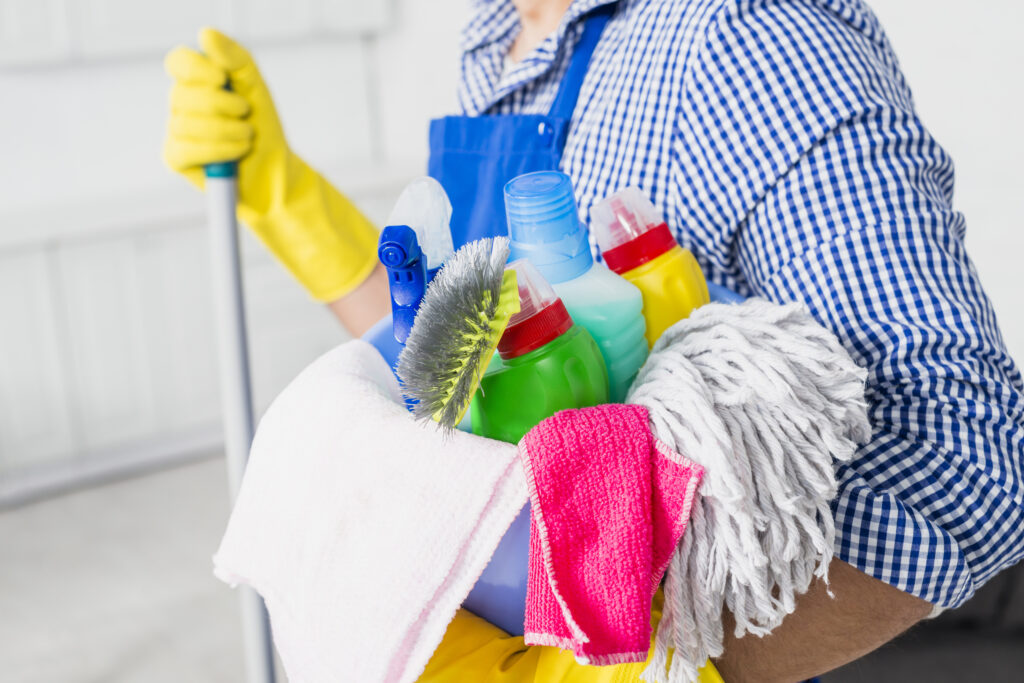The presence of PFAS in various household cleaning products is now widely recognized. Recent research from the EWG confirms these chemicals are found in many cleaners, waxes, varnishes, and aerosols used regularly. Even the ISSA, a trade association representing industrial cleaning professionals, admits to their historical use of PFAS in cleaning formulas and pledges to contribute to a PFAS-free future.
Yet, finding cleaning products that openly declare PFAS on their labels remains challenging.
Unintentional Contamination and Opaque Labelling
First, it’s important to recognize that PFAS are omnipresent in the environment, which often leads to unintentional contamination, where PFAS end up in products without the manufacturer’s knowledge.
For instance, the mechanical parts in production lines may be coated with PFAS to enhance lubrication or maintenance, and these PFAS can transfer to the finished product through abrasion. Water, the primary component of many cleaning products (about 70% in dish soap, for example), is frequently contaminated with PFAS, further contributing to their presence in cleaners.
Moreover, the labelling of chemical compositions on household products remains quite opaque, even though laws require transparency. The Regulation (EC) No 648/2004 of the European Parliament on detergents requires that “all ingredients shall be listed; in order of decreasing abundance by weight” and suggests that “manufacturers shall make [the ingredient list] available on a website the ingredient datasheet“. However, most product labels still show limited, often confusing information, and very few include the necessary website address. As a result, some governments are trying to further control the labelling of hazardous cleaners, like in France where a new labeling system called Toxic-score is being designed, which will help consumers assess the risk levels of using such products.
PFAS in “Anti-“x Products
So how can you navigate this maze? How do you know if your favorite fabric softener or hand soap contains PFAS?
Remember that PFAS gained widespread use because of their unique properties, such as resistance to water, stains, and grease. Therefore, it’s logical to find them regularly in products that tout these characteristics, such as:
- Carpet and fabric cleaners: PFAS prevent liquids from penetrating fibers, making fabrics stain-resistant.
- Furniture polishes and floor waxes: They create a waterproof barrier, protecting surfaces from water and oil stains while increasing shine and reducing scratches.
- Glass and mirror cleaners: PFAS help prevent watermarks and residues on glass surfaces.
- Dust repellents and aerosols: They create a protective layer that repels dust and moisture.
- Waterproofing sprays for shoes and clothing: Again, PFAS form a waterproof layer that repels water molecules, preventing them from soaking into fabric or leather.
This list is not exhaustive. While product labels are rarely complete, stay vigilant and watch out for polytetrafluoroethylene (PTFE), perfluorooctanoic acid (PFOA), or any compound with the root “fluoro“.

Skin Absorption of PFAS
Although ingestion remains the primary route of PFAS exposure for humans, prolonged skin contact can also lead to absorption. Handling cleaning products containing PFAS allows these substances to penetrate the skin and accumulate in the body. A recent study found that up to 13% of PFOA applied to the skin could enter the bloodstream.
Remember, PFAS exposure is linked to various health issues, especially for unborn children, developing kids, and immunocompromised individuals. Autism, obesity, developmental disorders, heart diseases — many ongoing studies are linking PFAS to the rise of certain health conditions in our society.
Protect Yourself and Your Family
To reduce exposure to PFAS during cleaning, follow these tips:
- Wear rubber gloves to avoid direct contact with products containing PFAS.
- Wash your hands after using cleaning products, especially if you didn’t wear gloves.
- Choose PFAS-free cleaning alternatives.
- Ventilate rooms during and after cleaning.
- Avoid aerosol products as PFAS can become airborne.
- Opt for natural cleaners like vinegar, baking soda, or DIY solutions.
Stay Informed!
In conclusion, while PFAS are widespread in cleaning products, solutions exist to limit your exposure. Choose alternatives without PFAS and adopt simple habits to protect your health. And to stay updated on the issue, regularly check our blog at infopfas.com, and follow us on social media!
Sources :
- ‘Forever chemicals’ – the part of cleaning you don’t want to last, Environmental Working Group
- The Impact of PFAS Regulations on the Cleaning Industry, ISSA
- La composition des produits ménagers, Sous l’étiquette
- Regulation (EC) No 648/2004 of the European Parliament and of the Council of 31 March 2004 on detergents, European Union
- État des lieux de la réglementation encadrant l’information du consommateur, DGCCRF
- Environnement : Vers l’élaboration d’un Toxi-Score, INSERM
- New study confirms forever chemicals are absorbed through human skin, Phys Org
- Inside Your Cleaning Products: What Cleaning Products Contain Pfas, Cleaning Team
- Cleaning Without Compromise: Your Guide to PFAS-Free Cleaning Products, Clean Product List
- California to Ban PFAS in Everyday Cleaning Products, Exponent
- Floor waxing could be an important source of PFAS contamination, with increased occupational health risks for workers, Gillings School of Global Public Health
- Avoid PFAS in waterproofing sprays, Forbrugerradet taenk
*Images by Freepik



